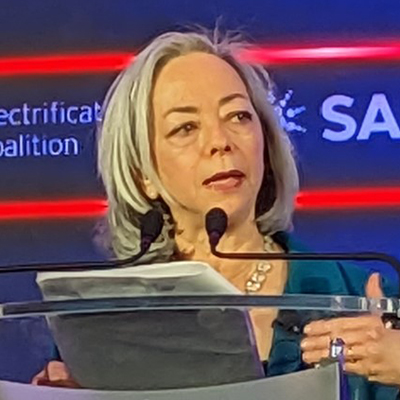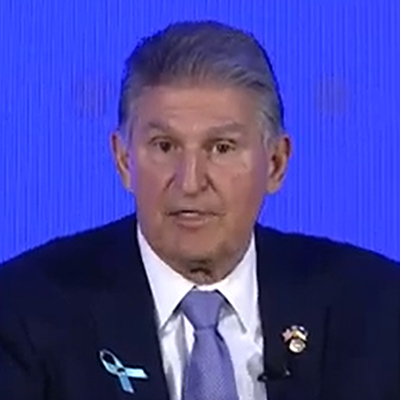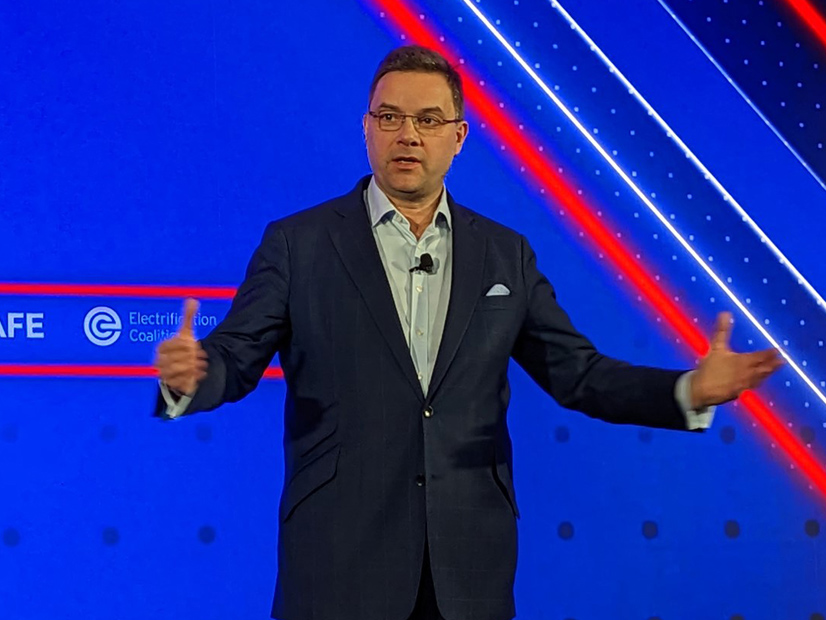WASHINGTON ― Tracing the lithium and cobalt in an electric vehicle battery is not the same as tracing a strawberry from field to fork, Circulor CEO Douglas Johnson-Poensgen told the audience at the SAFE Summit on Tuesday.
A strawberry will be more or less identifiable as a strawberry at both ends of the process, Johnson-Poensgen said. Minerals are different, and Circulor has developed software that provides a digital identifier that can “actually tell a story of a product that has undergone multiple stages of metamorphosis during its journey,” he said.
“Your supply chain is not linear,” Johnson-Poensgen said. “It’s not a series of one-to-one relationships, and so you have to be able to deal not just with the flow of those materials, through multiple participants where trading relationships between participants in the supply chain change largely based on price and availability. … A time stamp for those transactions is quite important when the time between mine and car can be measured in many, many months.”
A key theme at the SAFE Summit, the transparency and traceability of critical minerals and other battery components will be essential for automakers as they work to meet the domestic content provisions of the Inflation Reduction Act’s electric vehicle tax credits, which the Treasury Department issued Friday. (See Fewer EVs May Get IRA Tax Credit Under New Domestic Content Rules.)
To ensure their customers can qualify for the full $7,500 credit, U.S. and foreign automakers will have to be able to certify that at least 40% of the critical minerals in the batteries of their 2023 EV models were sourced and processed in the U.S. or a country with which the U.S. has a free-trade agreement.
At least 50% of other battery components will have to be similarly sourced, and the guidelines lay out multistep processes automakers must follow to verify their vehicles qualify for the credit. Failing to meet those requirements when the new provisions go into effect on April 18 could mean EVs that currently qualify for the full credit may only receive half — $3,750 — or none at all.
Speaking Thursday at a media briefing on the new guidelines, Treasury Department officials could not say which of the more than 20 models of EVs and plug-in hybrids they currently list as qualifying for the $7,500 credit will be affected when the new guidelines go into effect on April 18. An updated list will be posted by that date, officials said.
FEOCs
The guidelines’ prohibition on the use of any battery components or critical minerals produced by “foreign entities of concern” (FEOCs), scheduled to go into effect in 2024 and 2025, respectively, could be another big hit for U.S. and foreign automakers, and require another level of transparency and traceability.
Treasury has yet to release guidelines on these provisions, in particular on how FEOC will be defined.
At present, industry stakeholders have pointed to the State Department’s definition, which classifies China, Russia, North Korea and Iran as FEOCs.
 Thea Lee, Department of Labor | © RTO Insider LLC
Thea Lee, Department of Labor | © RTO Insider LLCFuture guidelines will likely focus on ensuring no minerals or components used in EVs sold in the U.S. come from countries where child and forced labor have been documented. Citing figures from the International Labor Organization, Thea Lee, deputy undersecretary for international affairs at the Labor Department, told the SAFE Summit that 27 million people are trapped in forced labor worldwide, “many of them … in mines and factories that supply raw materials for the green energy sector.”
Cobalt mined in the Democratic Republic of Congo with child labor is a “key input for many lithium-ion batteries made in China, and so we are now listing Chinese lithium-ion batteries as being produced with material made from child labor,” Lee said.
Artisanal mining — informal, small-scale projects — employs millions in the Congo, so, “responsible sourcing” will require “formalization,” she said. “Formalization will standardize safety, environmental and labor protections for workers. It means integrating worker voice, high labor standards and accountability for labor rights violations into your due diligence process.”
The Labor Department has launched a Global Trace Protocol Project aimed at providing traceability tools that can provide transparency on child and forced labor, Lee said. Circulor is one of several organizations currently working on systems, many of them blockchain-based, to allow tracing of child labor in the Congo’s cobalt mines, according to a May 2022 report on the Global Trace project website.
Johnson-Poensgen foresees new EVs rolling off production lines with “battery passports,” based on a combination of databases and machine learning, which would contain a full record of the vehicle’s supply chain. Some European carmakers are already providing such passports for their vehicles for about $10 per EV, he said.
The FTA Loophole
The IRA and Treasury guidelines still contain some significant loopholes, the biggest being the law’s vague definition of “free trade agreement” and the Treasury Department’s efforts to nail down a set of principles for what such an agreement might look like.
The guidelines call for agreements that “reduce or eliminate trade barriers on a preferential basis, commit the parties to refrain from imposing new trade barriers [and] establish high-standard disciplines in key areas affecting trade.”
These and other requirements detailed by Treasury were incorporated into a critical mineral agreement the U.S. signed with Japan on March 28. Similar agreements with the European Union and the United Kingdom could be forthcoming, according to industry analysts ClearView Energy Partners.
 Sen. Joe Manchin (D-W. Va.) | SAFE
Sen. Joe Manchin (D-W. Va.) | SAFEClearView sees the guidelines as reflecting an ongoing tension between the desire to accelerate EV adoption (decarbonization) and building out the U.S. supply chain (deglobalization), but definitely leaning more to the decarbonization side.
For example, the guidelines “would treat battery ‘constituent materials’ as ‘critical minerals’ that can be sourced from FTA countries (as opposed to ‘battery components’ that must be manufactured or assembled in North America),” ClearView said in its analysis of the guidelines.
The FTA principles and the critical mineral agreement with Japan drew criticism from top Democrats, such as Senate Finance Chair Ron Wyden (D-Ore.) and House Ways and Means Ranking Member Richard Neal (D-Mass.), who said they contained no environmental or labor safeguards.
“Mining is a challenging business, with ongoing violations of workers’ rights, child labor, forced labor, environmental degradation, and toxic chemical exposure all present in the industry,” Wyden and Neal said in a joint press release. “Even among allies, the United States should only enter into agreements that account for the realities of an industry, learn from past agreements, and raise standards.”
Further, the lawmakers argued that Biden does not have the unilateral authority to enter trade agreements without congressional approval.
Sen. Joe Manchin (D-W. Va.), who authored the domestic content provisions of the IRA, was even more critical, arguing that “the guidance released by the Department of the Treasury completely ignores the intent of the Inflation Reduction Act. It is horrific that the Administration continues to ignore the purpose of the law which is to bring manufacturing back to America and ensure we have reliable and secure supply chains. American tax dollars should not be used to support manufacturing jobs overseas,” Manchin said in a statement released Friday.
Speaking at the SAFE Summit on Thursday, Manchin sent mixed messages, first saying, “I’ve always felt that our allies were part of a secure supply chain.” But like Wyden and Neal, he sees definitions in the Treasury guidelines for free trade agreements and other provisions in the law as giving too much away.
“What I’m most concerned about is how they classify the processing with ‘manufacturing,’” Manchin said. “‘Manufacturing’ is meant to bring manufacturing back to the United States. It’s not basically allowing everyone to put all the parts and build everything you can for the battery somewhere else and then send it here for assembling. That bill does not specifically in any way, shape or form refer to ‘assembling.’ It says ‘manufacturing.’”
Further, he said, the IRA has already galvanized foreign investment in the U.S. “This is the most attraction [we’ve] ever had, and you see so much demand. This could bring $3 trillion pretty well rapidly to our country for manufacturing. …
“I want a solid, safe, dependable supply chain,” he said. At the summit, Manchin threatened to go to court to stop implementation of the guidelines if they do not reflect the intent of the law as he wrote it ― a threat not repeated in his Friday statement.
Taking the Long View
The political battles notwithstanding, the key issue arising from the new guidelines is whether the loss of tax credits will, in the short term, cut into EV sales. The view from the Treasury Department is that any short-term reduction in models eligible for the full tax credit will be offset by the buildout of a domestic supply chain, which over the next decade will make more EVs available and eligible for the credit.
President Biden has set a goal for 50% of all new car sales in the U.S. to be zero-emission vehicles by 2030, and he sees the tax credit as a major incentive for getting more Americans driving electric.
To counter any dampening effect from the new guidelines, the White House has been promoting the wave of new investments in EV battery manufacturing in the U.S. ― also supported by clean energy manufacturing tax credits and other incentives in the IRA ― as well as corporate commitments to electrifying vehicle fleets.
An estimated $90 billion in private investments have poured into new efforts to build out an EV battery supply chain in the U.S. since Biden took office, with half that amount announced since passage of the IRA, according to a senior administration official speaking at Thursday’s media briefing.
The White House also announced new public and private commitments to vehicle electrification as part of Biden’s EV Acceleration Challenge, launched earlier this year.
The federal government has acquired 13,000 ZEVs so far in fiscal 2023, and federal agencies have committed to installing 24,000 charging stations at their facilities across the country by the end of the fiscal year on Sept. 30, according to a White House fact sheet.
In the private sector, First Student, a supplier of school bus services, has committed to transitioning 30,000 fossil fuel-powered school buses to electric by 2035, while battery recycler Cirba Solutions recently announced plans for a major new facility in South Carolina that will recycle enough lithium and other critical minerals to manufacture 500,000 EVs.
Pent-up Demand
Immediate reactions to the guidelines from carmakers and trade groups acknowledged the negative short-term impacts but similarly focused on longer-term market growth.
“The guidance provides the clarity industry needs to invest in more secure and reliable supply chains for critical minerals and battery components with our allies,” said SAFE CEO Robbie Diamond, while also calling for careful work on the definition of FEOCs.
“How we define and enforce these provisions will make or break the national security benefits of the IRA and will require vigilance and rigorous enforcement to ensure that China and other foreign entities of concern don’t re-infiltrate our supply network,” Diamond said. “Ultimately, it’s imperative that we expand the circle of allies and partners who can benefit from and contribute to our supply chains.”
Speaking at the SAFE Summit, Jeffrey Morrison, vice president of global purchasing and supply chains for General Motors, said GM began work on its domestic supply chain more than a year before the IRA was signed into law in August.
“We knew that the capacity we needed wasn’t there. We had to build new capacity, and we wanted to have a more resilient value chain … than what exists today,” he said.
GM kept the spin positive in a statement issued following the release of the guidelines. Committed to phasing out new gas-powered models and going full electric by 2035, the company called tax credits “a proven accelerator of electric vehicle adoption.”
GM expects its Cadillac Lyriq electric SUV will qualify for the full $7,500 tax credit, as will two other electric SUVs to be released this year, the Chevrolet Equinox and Blazer. However, Chevy’s popular Bolt and Bolt EUV models may only be eligible for a $3,750 credit, the company said.
Echoing Treasury officials, John Bozzella, CEO of the Alliance for Automotive Innovation, an industry trade group, said the number of EVs qualifying for the full tax credit will go down, but he couldn’t say which models might or might not qualify after April 18.
But, in a blog on the AAI website, Bozzella called the first quarter of 2023 the “highwater mark” for EV tax credit eligibility since passage of the IRA. He also pointed to rising figures for EV sales ― 8.5% of new car sales in the U.S. in the fourth quarter of 2022 ― as a sign of ongoing growth.
Phil Jones, CEO of the Alliance for Transportation Electrification, also foresees a “hiccup” in the EV market as automakers adjust to the new guidelines and focus on domestic supply chains. “There will be some slowdowns for certain vehicles and certain manufacturers, obviously, because consumers are price-sensitive,” Jones said in an interview with NetZero Insider.
“But I don’t think it’s going to be significant,” he said. “There’s so much pent-up demand for these vehicles out there, and the major issues, in my view … it’s chips; it’s semiconductors; it’s components of an automobile other than the battery.”


